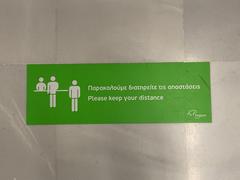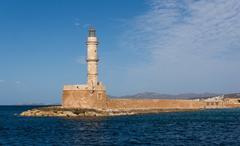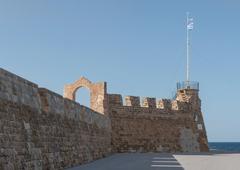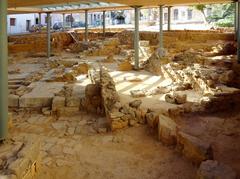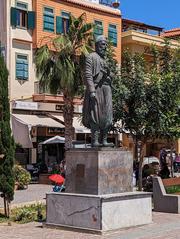Archaeological Museum of Chania: Complete Visiting Guide, Hours, Tickets, and Insider Tips
Date: 03/07/2025
Introduction
The Archaeological Museum of Chania stands as a premier cultural landmark in western Crete, guiding visitors through the island’s rich and layered history—from the earliest prehistoric settlements to the height of Roman influence. Located in the historic Chalepa district, the museum is celebrated not only for its remarkable collections but also for its innovative architecture, which bridges Crete’s ancient heritage with cutting-edge design (amch.gr; for91days.com).
This detailed guide presents everything you need to plan and enrich your visit: historical background, architectural highlights, key artifacts, practical visitor information, accessibility features, educational programs, travel tips, and insider recommendations. Whether you are an archaeology enthusiast, architecture lover, or a curious traveler, this resource will help you experience the very best of the Archaeological Museum of Chania (Destination Crete; discovergreece.com; explorechania.com).
Historical Background and Architectural Significance
Museum Origins and Evolution
The museum’s roots date to the late 19th century, arising from the Cretan State’s efforts to protect and display local antiquities. Established by legislation in 1899, its collection began with artifacts from Chania, Sfakia, and Rethymnon, including major donations like the Michael Tsivourakis collection, which formed the foundation of the early exhibits (amch.gr). The initial location in the Government House proved unsuitable, and the collection faced major challenges—most notably a devastating fire in 1934 and looting during World War II (amch.gr).
Relocation and Growth
After World War II, the museum found a new home in the Venetian Monastery of St Francis in Chania’s Old Town. This historic church, with its high vaulted ceilings and Venetian architectural features, provided a striking setting for the museum’s treasures for nearly sixty years (for91days.com).
By the 1990s, the need for modern facilities led to the construction of a new museum in Chalepa. Completed in 2022 and designed by Theofanis Bobotis and team, the new building combines advanced museology, environmental sustainability, and accessibility (amch.gr; bobotisarchitects.com; archidiaries.com).
Architectural Highlights
- Site and Layout: Set on a hilltop in Chalepa, the museum offers panoramic views of Chania and the sea. The triangular building’s brick façade, cobblestone details, and interior atrium allow for abundant natural light and a seamless visitor flow (amch.gr).
- Interior Design: Exhibition spaces are arranged for intuitive movement, with crisp white walls, parquet floors, and state-of-the-art lighting that protects and enhances the artifacts (bobotisarchitects.com).
- Technological and Environmental Features: The museum incorporates energy-efficient systems, climate controls, and sustainable materials, supporting both artifact preservation and environmental responsibility (travel.gr).
The Collections: Chronological and Thematic Exploration
Prehistoric and Minoan Artifacts
Neolithic and Early Bronze Age
The earliest finds include stone tools, obsidian blades, and primitive ceramics, illuminating the daily lives and technological advances of Crete’s first inhabitants.
Minoan Civilization
The museum is renowned for its Minoan artifacts (ca. 3000–1100 BCE):
- Ceramics: From simple domestic wares to decorative Kamares pottery, the ceramics showcase artistic skill and Minoan trade links.
- Seal Engravings: Intricately carved seals highlight Minoan administrative systems and religious iconography.
- Jewelry and Metalwork: Gold, silver, and bronze adornments reflect the sophistication of Minoan artisans (Terrabook Chania).
- The Mitsotakis Collection: Donated in 2000, this celebrated collection features rare pottery, stone carvings, and seals, representing a third of the museum’s holdings (Destination Crete).
Historical Periods: Geometric to Roman
Geometric, Archaic, and Classical Eras
Artifacts from these periods (ca. 900–323 BCE) include:
- Pottery: Characterized by geometric patterns and stylized motifs.
- Figurines and Sculptures: Terracotta and bronze figures representing deities and daily life.
- Inscriptions: Stone fragments and columns provide glimpses into ancient governance and society.
Hellenistic and Roman Periods
- Roman Mosaics: Fine mosaic floors from the 2nd–3rd centuries CE, illustrating mythological scenes such as Dionysian cycles and Poseidon’s myths (Destination Crete).
- Statues and Busts: Marble works depicting gods, emperors, and dignitaries.
- Coins and Jewelry: Spanning several centuries, these pieces reflect both local and broader Mediterranean influences.
Notable Artifacts
- The Minoan “Master’s Seal”: A Late Minoan artifact depicting detailed architectural elements, fortifications, and ceremonial scenes—an invaluable source for understanding Minoan society (thearchaeologist.org).
- Roman Mosaic Floors: Vibrant, well-preserved mosaics that are among the museum’s most celebrated pieces.
- Proto-Minoan Bird-Like Vessels, Gold Medusa Diadem, and Daedalic Busts: Highlights from the Mitsotakis Collection.
Visitor Information
Location and Access
- Address: 15 Skra Street, Chalepa, Chania, 731 33
- Getting There: Accessible by bus (chaniabus.gr), taxi, car (with on-site parking), or a 25–30-minute scenic walk from Old Town (amch.gr).
Opening Hours
- Monday, Wednesday–Sunday: 08:00–20:00
- Tuesday: Closed
- Last entry: 20 minutes before closing (amch.gr).
Ticket Prices
- April–October: Standard adult €8; reduced €4 (students, seniors); free for children under 18, archaeology students, Chania residents (amch.gr).
- November–March: Reduced rates for all visitors.
- Where to Buy: On-site or official online platform.
Guided Tours and Audio Guides
- Daily guided tours in English and Greek (advance booking recommended).
- Audio guides and multimedia presentations available for self-guided visits.
Facilities
- Café: Overlooking the city and sea.
- Museum Shop: Books, souvenirs, replicas.
- Restrooms: Fully accessible, located on both floors.
- Family-Friendly: Stroller access and educational programs for children.
- Workshops: Spaces for ceramics, conservation, and educational activities.
- Amphitheatre and Event Spaces: For lectures, workshops, and community events.
Accessibility and Inclusivity
- Fully wheelchair accessible with ramps, lifts, and accessible restrooms.
- Tactile exhibits and Braille signage for visually impaired visitors (explorechania.com).
- Multilingual labels and guides.
COVID-19 Guidelines
- Check the official website for current protocols.
Enhancing Your Visit: Tips and Nearby Attractions
Best Times to Visit
- Early morning or late afternoon for a quieter experience and optimal photography.
- Spring and autumn offer mild weather and fewer crowds (discovergreece.com).
Photography
- Non-flash photography is allowed in most areas; check for restrictions.
Conduct
- Food and drink are not permitted in exhibition spaces; large bags may require storage.
Nearby Attractions
- Venetian Old Town
- Firkas Fortress
- Maritime Museum of Crete
- Eleftherios Venizelos House and historic Chalepa mansions
Educational Programs, Special Events, and Community Engagement
Education and Public Programs
- Guided school visits, hands-on workshops, and educational materials aligned with national curricula (amch.gr).
- Temporary exhibitions, such as “ArTies: 8 Modern Sculptures ∞ Endless Timeless Bonds” and “BATH TIME! Body – Water – Dialogues” (Argophilia; amch.gr).
- Public lectures, concerts, and anniversary events.
Digital and Accessibility Initiatives
- Virtual tours and multimedia resources on the museum’s official website.
- Tactile and Braille exhibits for visually impaired visitors.
- Multilingual information for international audiences.
Community and Research
- Collaborations with local universities and organizations for research and conservation.
- Displays highlighting the archaeological heritage of ancient Kydonia and other Chania communities (travel.gr).
Sustainability
- Bioclimatic building design with energy-efficient systems and sustainable materials (travel.gr).
Frequently Asked Questions (FAQ)
Q: What are the Archaeological Museum of Chania visiting hours?
A: Monday, Wednesday–Sunday, 08:00–20:00; closed Tuesdays; last entry 20 minutes before closing.
Q: How much are tickets?
A: Adults: €8 (April–October), €4 (reduced). Free for children under 18, archaeology students, and Chania residents. Check for seasonal discounts.
Q: Is the museum accessible for people with disabilities?
A: Yes, with ramps, lifts, accessible restrooms, tactile exhibits, and Braille signage.
Q: Are guided tours available?
A: Yes, in multiple languages; booking recommended.
Q: Can I take photographs?
A: Non-flash photography is allowed in most areas unless otherwise indicated.
Q: What are nearby attractions?
A: Venetian Harbor, Firkas Fortress, Maritime Museum of Crete, Eleftherios Venizelos House.
Insider Recommendations
- Book a guided tour for expert insights.
- Visit the café for panoramic views after your tour.
- Pair your museum visit with walks through Chalepa and the Old Town.
- Check the museum’s website and social media for special events and exhibitions.
- Download the Audiala app for self-guided tours and up-to-date cultural content.
Summary
The Archaeological Museum of Chania exemplifies Crete’s dedication to preserving and sharing its archaeological legacy. From Neolithic tools to Roman mosaics and the exceptional Mitsotakis Collection, the museum offers a rich, immersive journey through history. Its state-of-the-art, sustainable building provides a comfortable, inclusive, and engaging environment for all visitors. With extensive educational programs, community outreach, and a prime location near Chania’s top historical sites, the museum is a cultural hub and essential destination for anyone seeking to understand Crete’s vibrant past and present (amch.gr; thearchaeologist.org; bobotisarchitects.com; travel.gr; chaniatourism.gr).
Plan Your Visit
For the latest updates on visiting hours, ticketing, exhibitions, and special events, visit the official museum website. Enhance your exploration by downloading the Audiala app, which offers audio guides and curated content on Chania’s historical and cultural attractions. Follow the museum and Audiala on social media for news, events, and travel inspiration.
Sources and Further Reading
- Archaeological Museum of Chania: History, Architecture, Tickets, and Visitor Guide, 2025, amch.gr
- Archaeological Museum of Chania: Visiting Hours, Tickets & Key Exhibits, 2025, Destination Crete
- Archaeological Museum of Chania Visiting Hours and Tickets: Explore Chania’s Historical Sites, 2025, discovergreece.com
- Visiting the Archaeological Museum of Chania: Hours, Tickets & Insider Tips, 2025, amch.gr
- The Archaeological Museum of Chania: History and Architecture, 2024, for91days.com
- Archaeological Museum of Chania by Bobotis + Bobotis Architects, 2024, bobotisarchitects.com
- Decoding the Minoan Master’s Seal: Architectural and Religious Symbolism in Minoan Civilization, 2024, thearchaeologist.org
- Top Archaeological Sites and Museums of Chania, 2025, travel.gr
- Archaeological Museum of Chania: Education and Accessibility Initiatives, 2025, explorechania.com
- Chania Archaeological Museum Hosts Modern Sculptures Exhibition, 2025, Argophilia
- Archaeological Museum of Chania, 2025, chaniatourism.gr
Images and virtual tours are available via the museum’s official website and Explore Chania. For alt text and SEO optimization, use phrases such as “Archaeological Museum of Chania entrance,” “Minoan artifacts in Chania museum,” and “Chania museum panoramic view.”
